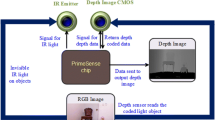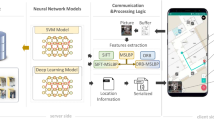Abstract
In this article, we propose a speeded-up robust features (SURF)-based approach for outdoor autonomous navigation. In this approach, we capture environmental images using an omni-directional camera and extract features of these images using SURF. We treat these features as landmarks to estimate a robot’s self-location and direction of motion. SURF features are invariant under scale changes and rotation, and are robust under image noise, changes in light conditions, and changes of viewpoint. Therefore, SURF features are appropriate for the self-location estimation and navigation of a robot. The mobile robot navigation method consists of two modes, the teaching mode and the navigation mode. In the teaching mode, we teach a navigation course. In the navigation mode, the mobile robot navigates along the teaching course autonomously. In our experiment, the outdoor teaching course was about 150 m long, the average speed was 2.9 km/h, and the maximum trajectory error was 3.3 m. The processing time of SURF was several times shorter than that of scale-invariant feature transform (SIFT). Therefore, the navigation speed of the mobile robot was similar to the walking speed of a person.
Similar content being viewed by others
Explore related subjects
Discover the latest articles, news and stories from top researchers in related subjects.References
DARPA Urban Challenge (2007) http://archive.darpa.mil/grandchallenge/index.asp
Real World Robot Challenge (2007) http://www.ntf.or.jp/challenge/
Thrapp R, Westbrook C, Subramanian D (2001) Robust localization algorithms for an autonomous campus tour guide. Proceedings of the 2001 IEEE International Conference on Robotics and Automation, pp 2065–2071
Ohno K, Tsubouchi T, Shigematsu B, et al (2004) Differential GPS and odometry-based outdoor navigation of a mobile robot. Adv Robotics 18(6):611–635
Horswill I (1993) Polly: a vision-based artificial agent. Proceedings of the International Conference on AAAI’ 93, pp 824–829
Matsumoto Y, Inaba M, Inoue H (2000) View-based approach to robot navigation. Proceedings of the 2000 IEEE/RSJ International Conference on Intelligent Robots and Systems, pp 1702–1708
Morita H, Hild M, Miura J, et al (2005) View-based localization in outdoor environments using support vector learning. Proceedings of the 2005 IEEE/RSJ International Conference on Intelligent Robots and Systems, pp 3083–3088
Bay H, Ess A, Tuytelaars T, et al (2008) Speeded-up robust features (SURF). Computer Vision and Image Understanding 110(3): 346–359
Lowe DG (1999) Object recognition from local scale-invariant features. Proceedings of the IEEE International Conference on Computer Vision, pp 1150–1157
Author information
Authors and Affiliations
Corresponding author
Additional information
This work was presented in part at the 16th International Symposium on Artificial Life and Robotics, Oita, Japan, January 27–29, 2011
About this article
Cite this article
Tabuse, M., Kitaoka, T. & Nakai, D. Outdoor autonomous navigation using SURF features. Artif Life Robotics 16, 356–360 (2011). https://doi.org/10.1007/s10015-011-0950-8
Received:
Accepted:
Published:
Issue Date:
DOI: https://doi.org/10.1007/s10015-011-0950-8




